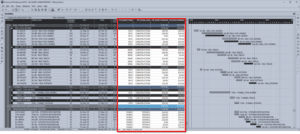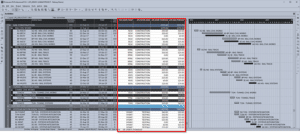Improved importing of spreadsheet data into Turbo-Chart to produce Time Location charts
Watch our quick guide on copy and pasting schedule data from Primavera P6 activity layouts to Turbo-Chart using the Paste Wizard. More detailed how-to video at the end of the article below.
Turbo-Chart is designed to work with many popular Scheduling tools, and offers direct connection to import data from these tools such as Primavera P6, MS Project, Asta Powerproject and Safran Risk/Planner.

In addition, any data that be prepared in spreadsheet ready data tables, can also be easily imported into Turbo-Chart using our Clipboard Paste Wizard.
Primavera P6 Data Importing Options
Turbo-Chart can connect to Primavera P6 data in different ways. Data can be imported into Turbo-Chart using XER files, but requires a new XER file to be created each time the P6 data changes. Direct connections to P6 databases, including SQLite standalone, and via P6 Webservices can also be made, and this enables instant synchronization as the P6 schedule data changes.
If you are unable to connect to your P6 database directly, the spreadsheet import option can be used to import Primavera P6 data into Turbo-chart, the Paste Wizard makes it possible to easily copy data from P6, and paste into Turbo-Chart as the schedules data changes.

Preparing Primavera P6 Schedule Data
For any method of importing data from P6, the preparation of the P6 data is the same. Activities in P6 are assigned additional data using User Defined Fields. These UDFs can then be used for any project within the P6 database
Numeric fields are used to define the linear start and end location values for activities. A ShapeCode is a text value that is used in Turbo-Chart to define how the activity is displayed, colors, shapes etc. An optional text value as a FilterCode can also be used
- Create User Defined Fields
- Location Start Value | Numeric
- Location End Value | Numeric
- ShapeCode | Text
- FilterCode | Text (optional)

Primavera P6 Activity Layout Tips
To copy Activity data from P6, create an activity layout that contains the data to be imported into Turbo-Chart. This layout can be a working layout that used as a part of normal schedule development and maintenance.
The column headers may can have any name, these will be mapped using the Paste Wizard in Turbo-Chart
Activity ID MUST be one of the columns as Turbo-Chart matches using Activity ID’s
Other columns that are recommended are:
- The ShapeCode UDF,
- The start and finish dates,
- The start and end location UDF fields,
- The FilterCode if being used, and
- Activity Descriptions, or any other text field that can be used to display descriptions
Using the P6 Critical data field will also enable the display of critical tasks in Turbo-Chart
Any other data columns can exist in the activity Layout, and these will be ignored by Turbo-Chart, likewise any Grouping and Sorting may be used, as these will also be ignored. Finally, the order of the columns is also not relevant for importing into Turbo-Chart
To select this data, highlight the require activities, or press CTRL+A to select all activities, then press CTRL+C to copy the data to your clipboard.

Using Turbo-Chart Paste Wizard
To paste data using the Paste Wizard, select DATA>TASKS and click on Paste Wizard. The first tab displayed shows data contained in the clipboard ready for processing by the wizard. Data needs to be tabular data, with the first row containing column headers.
The paste wizard options lets you map the fields in the clipboard data to those required by Turbo-Chart, indicating the required and preferred fields. Paste Info provides a summary of the wizards processing operation.
The second tab displays the clipboard data after processing by the wizard, and indicates whether the pasted data will create a new task in Turbo-Chart, or overwrite an existing task. There is also an option to automatically best-fit the active chart date and location axes based on the pasted data.
Then press Ok to import the clipboard data into Turbo-chart . The data is processed to remove all data rows that have no ShapeCode, and to tidy up date fields to remove actual and constraint references.
The paste wizard also maintains field mappings such that the next paste operation will remember the previous mapping options.

The image below presents an example of P6 Columns being renamed from their default values, and the mappings used by the Turbo-Chart clipboard Paste Wizard to import data

Watch the How-To-Guide on Copy and Pasting from Primavera P6 using the Paste Wizard
Further Help
Should you need further help regarding Turbo-Chart, we are here to support you!
Just send an email to support@pmerasupport.com




